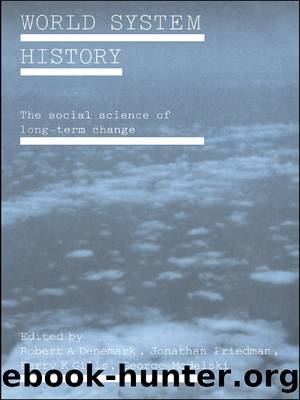World System History by Denemark Robert A.; Friedman Jonathan; Gills Barry K

Author:Denemark, Robert A.; Friedman, Jonathan; Gills, Barry K.
Language: eng
Format: epub
Tags: ebook, book
Publisher: Routledge
Published: 2011-09-20T16:00:00+00:00
Southern Mesopotamia itself was an agricultural and cattle-raising land which produced almost nothing else…As materials of exchange…the soil of southern Mesopotamia could only offer its agricultural produce such as barley, dates and sesame, or the products of cattle-raising such as butter, cheese and leather.
(Leemans 1960:115)
These articles were exported in large quantities by boat north along the Euphrates and south via the Persian Gulf.
Who were the workers? There were a growing number of slaves in the economically expansive centers in the south. The population increase in the south was initially accompanied by depopulation and the abandonment of sites in surrounding areas, both in the north (Akkermans 1989:347) and to the east, (Lamborg-Karlovsky and Beale 1986:267). The temples seem to have held large numbers of slave-women, gim, as workers. In one of the Uruk tablets, 211 female slaves are recorded, denoted by an ideograph that is usually interpreted as ‘woman from foreign mountainous country.’ They were used in textile production and household activities. Female slaves are found in industrial textile production all over the Near East and eastern Mediterranean in ancient times. According to Tyumenev (1973b:73) there is no equivalent ideograph in the earliest tablets for male slaves, which, of course, does not necessarily mean that they did not exist.
Male slaves appear alongside female slaves on stone inscriptions from the end of Uruk. Chattel slaves in the form of war captives became increasingly important in the political economy of Mesopotamia in later periods (Gelb 1973), especially in large-scale irrigation and construction work. The temples could not have been built without ‘armies of laborers.’ It is estimated that the labor force required for the sub-structure of the Anu Ziggurat at Uruk was 7,500 many years (Adams 1966:126). Among the workers were certainly also free and highly competent specialists, some of them from surrounding areas (cf. Kramer 1963:101). It seems probable that some of the foreign workers had to be bought or captured by force, while others may have come of their own accord.
‘(I)t is towards the end of the “Uruk period” that the momentous change we have described takes place,’ says Frankfort (1971:73), when discussing why it is not always useful to divide the process into Ubaid, Uruk and Early Dynastic. The most spectacular development thus seems to have taken place in late Uruk. But late Uruk embraced both an early phase of rapid development and a later phase characterized by contraction and crisis. The serious problems toward the end of Uruk appeared when Sumer’s life-supporting trade network was shattered. The very end of Uruk is characterized by internal warfare and by the destruction and abandonment of sites.
War evidently played a significant role during Uruk. There are cylinder seals depicting battle scenes and fettered war captives (see Postgate 1994:241, 25; Adams 1981:63). But it is worth noting that no striking development took place in arms technology during Uruk. This came later, in the Early Dynastic period. The Uruk system was, as mentioned above, characterized by the autonomy of each major center. Even if
Download
This site does not store any files on its server. We only index and link to content provided by other sites. Please contact the content providers to delete copyright contents if any and email us, we'll remove relevant links or contents immediately.
The Secret History by Donna Tartt(18157)
The Social Justice Warrior Handbook by Lisa De Pasquale(11951)
Thirteen Reasons Why by Jay Asher(8451)
This Is How You Lose Her by Junot Diaz(6434)
Weapons of Math Destruction by Cathy O'Neil(5828)
Zero to One by Peter Thiel(5488)
Beartown by Fredrik Backman(5350)
The Myth of the Strong Leader by Archie Brown(5237)
The Fire Next Time by James Baldwin(5016)
How Democracies Die by Steven Levitsky & Daniel Ziblatt(4951)
Promise Me, Dad by Joe Biden(4908)
Stone's Rules by Roger Stone(4854)
100 Deadly Skills by Clint Emerson(4688)
A Higher Loyalty: Truth, Lies, and Leadership by James Comey(4550)
Rise and Kill First by Ronen Bergman(4543)
Secrecy World by Jake Bernstein(4388)
The David Icke Guide to the Global Conspiracy (and how to end it) by David Icke(4377)
The Farm by Tom Rob Smith(4322)
The Doomsday Machine by Daniel Ellsberg(4243)
